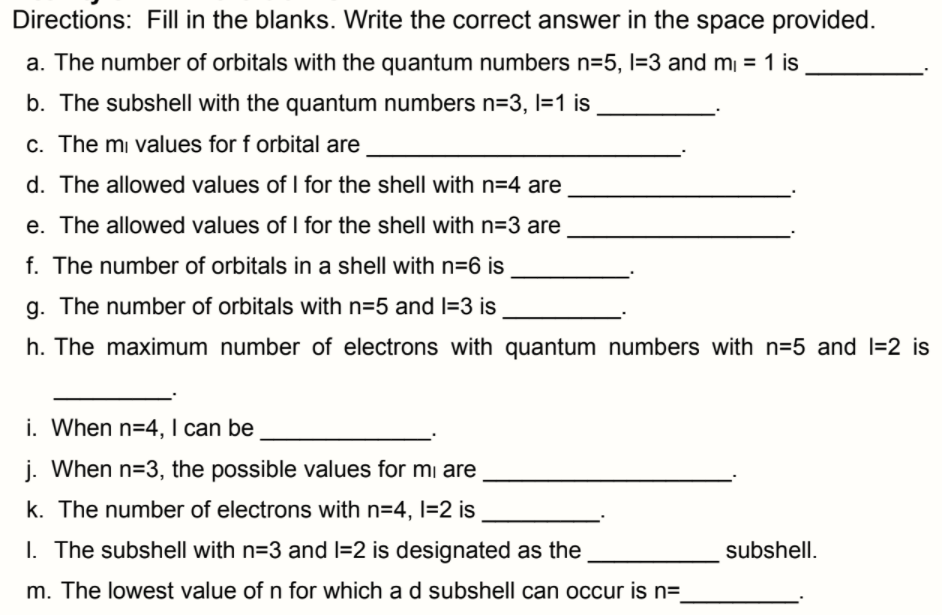Directions: Fill in the blanks. Write the correct answer in the space provided. a. The number of orbitals with the quantum numbers n=5, l=3 and m = 1 is b. The subshell with the quantum numbers n=3, l=1 is c. The mi values for f orbital are
Directions: Fill in the blanks. Write the correct answer in the space provided. a. The number of orbitals with the quantum numbers n=5, l=3 and m = 1 is b. The subshell with the quantum numbers n=3, l=1 is c. The mi values for f orbital are
Chapter7: Atomic Structure And Periodicity
Section: Chapter Questions
Problem 144AE: Although no currently known elements contain electrons in g orbitals in the ground state, it is...
Related questions
Question

Transcribed Image Text:Directions: Fill in the blanks. Write the correct answer in the space provided.
a. The number of orbitals with the quantum numbers n=5, l=3 and m¡ = 1 is
b. The subshell with the quantum numbers n=3, l=1 is
c. The mi values for f orbital are
d. The allowed values of I for the shell with n=4 are
e. The allowed values of I for the shell with n=3 are
f. The number of orbitals in a shell with n=6 is
g. The number of orbitals with n=5 and I=3 is
h. The maximum number of electrons with quantum numbers with n=5 and l=2 is
i. When n=4, I can be
j. When n=3, the possible values for mi are
k. The number of electrons with n=4, l=2 is
I. The subshell with n=3 and I=2 is designated as the
subshell.
m. The lowest value of n for which a d subshell can occur is n=
Expert Solution
This question has been solved!
Explore an expertly crafted, step-by-step solution for a thorough understanding of key concepts.
This is a popular solution!
Trending now
This is a popular solution!
Step by step
Solved in 2 steps with 2 images

Knowledge Booster
Learn more about
Need a deep-dive on the concept behind this application? Look no further. Learn more about this topic, chemistry and related others by exploring similar questions and additional content below.Recommended textbooks for you


Chemistry
Chemistry
ISBN:
9781305957404
Author:
Steven S. Zumdahl, Susan A. Zumdahl, Donald J. DeCoste
Publisher:
Cengage Learning

Chemistry: An Atoms First Approach
Chemistry
ISBN:
9781305079243
Author:
Steven S. Zumdahl, Susan A. Zumdahl
Publisher:
Cengage Learning


Chemistry
Chemistry
ISBN:
9781305957404
Author:
Steven S. Zumdahl, Susan A. Zumdahl, Donald J. DeCoste
Publisher:
Cengage Learning

Chemistry: An Atoms First Approach
Chemistry
ISBN:
9781305079243
Author:
Steven S. Zumdahl, Susan A. Zumdahl
Publisher:
Cengage Learning

Chemistry: Principles and Practice
Chemistry
ISBN:
9780534420123
Author:
Daniel L. Reger, Scott R. Goode, David W. Ball, Edward Mercer
Publisher:
Cengage Learning

Chemistry & Chemical Reactivity
Chemistry
ISBN:
9781337399074
Author:
John C. Kotz, Paul M. Treichel, John Townsend, David Treichel
Publisher:
Cengage Learning

Chemistry & Chemical Reactivity
Chemistry
ISBN:
9781133949640
Author:
John C. Kotz, Paul M. Treichel, John Townsend, David Treichel
Publisher:
Cengage Learning